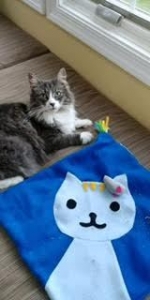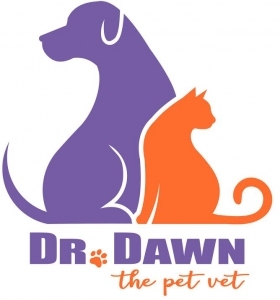This summer, we have had lots of fun with several new kitten additions to our hospital family. This picture shows us and two such adorable littermates. What is not evident in this picture is that it took us 7 attempts to get them to stay still long enough to both face the camera at the same time. We gave up at 7 attempts. That’s because kittens are active, squirmy, fur balls of energy, that like to play, explore,chase, eat, sleep,….repeat. It is a normal part of their development. But, when they are kept indoors, it can be a challenge keep them safely busy and entertained, without them hurting themselves or getting into trouble and destroying furniture, etc. In lieu allowing them access to the outdoors, where there are many more risks to their safety, I encourage providing an indoor environment that suits their needs.
To do so, it is important to understand that they need stimulation and play. Social play begins at around a month of age, peaks at 8-9 weeks of age. It is normal for them to wrestle and “play” fight, but only if no serious injuries are sustained.
Object play starts around 6 weeks of age. Examples are stalking, pouncing, biting objects, and pawing at things. This can turn negative if it is directed at adult cats, or people in the home.
Locomotory play can be social or seen in single #cat households, also around 6 weeks of age. Examples include running, jumping and climbing.
All of these behaviors are seen in adult cats, but to a lesser degree.
If the kittens or cats are under stimulated, and have an excess of energy and lack of an outlet to release that energy, it can lead to undesirable aggressive play behavior, destructiveness, and excessive nighttime activity.
A playmate, is a great, constant way to help entertain a cat. That is not always an option, depending on the cat personalities of the cats involved, space, finances, etc. You can, thus, function as the playmate, and can have interacting and exercise sessions that will provide them with your attention, and an outlet for their energy and need to explore. Cats and kittens typically are stimulated by moving objects that they can stalk, chase, or pounch upon. Lights or flashlights that they can track work well with some cats. Interactive toys such as wiggling ropes, dangling feathers on sticks, or things rolled toward them, may be preferred by other cats.
For self play, in your absence, objects that roll, such as ping pong balls, or toys that are dangled, battery operated, and scratching posts can offer a variety of independent play options. Empty paper bags or boxes are great, as are new climbing areas and perches which give them opportunities to scratch, as well as survey their environment from different vantage points. The noise made while playing with crinkly toys seems to stimulate some cats. Having appropriate scratching sites, ideally in several locations, allows them to scratch non-furniture surfaces, and helps “cat proof” your home.
Catnip treated toys, or those with it hidden inside, may help stimulate play and exploration. Particularly those cats that have time alone, and who enjoy catnip, will benefit from access to it.
Most items described so far are available in pet supply stores. Most are inexpensive. Some are more costly, and may appeal to your cat, such as the kitty exercise wheel. I have yet to get feedback from clients whose cats have used and enjoy this wheel. If so, please send comments with your personal experience with it.
I encourage access to toys that are portable, and have various stimuli in one place, without the chance of pieces breaking off or being chewed off, potentially becoming obstructive foreign bodies.
I recommend, and endorse, the Kitty Cat Mat, available through the link below. It is an example of several of the above described stimulating play options in one item.
https://www.kittycatmat.com/?mid=9579306
Here is a patient enjoying the mat.
Cats often tire of one activity, and move on to another, so variety, offered in various places and alternating in when you bring them out, may help keep them interested in the toys.
Dr. Dawn
Please Share and Subscribe here















